Viernes Santo 2008, part 1
Indulging the photographic itch is difficult when you have an infant. Parenthood makes me reassess my priorities. I could no longer do things that I take for granted in the past. On-the-spot vacations can no longer be and everything have to be planned ahead. Even a trip to the mall needs a game plan – where can we change diapers? what if she fussed and cried? This Holy Week then, I was in a quandary. I traditionally would like to check out old churches, as it is the time to photograph antique icons which only get the light of day this time of the year. Too bad. This year would be different. I am homebound.
With the Holy Week almost over, I had to muster all of what’s left of my sapped energy to attend the local procession in Talamban, where I settled since I got married last year. I was not expecting anything grandiose as the parish is relatively new. The church is probably at most 40 years old.
But Talamban isn’t exactly a small community and I was not disappointed. Traditions remain deep-rooted in Catholic Philippines and the Viernes Santo (Good Friday) procession was a fulfilling spiritual exercise and an enjoyable photographic journey.
Imahen
I counted at least 9 images and 3 tableaux in the procession, all of which can safely be assumed as private patronages of families living in Talamban. There were no century old antiques although the Santo Entierro does look old.
As I took the pictures I realized one glaring fact, that the icons of the holy women were not identified. When I got back home, I then checked into my “reliable” source of local iconography- Flickr’s own Semana Santa Filipinas which has a lively discussion thread on the women in the Passion of Jesus regularly featured in Holy Week processions. My thinking was that I could identify the images based on the religious symbols that they bear. Wrong!
I soon realized that in the Philippines, where folk Catholicism is strong, symbols and attributes are a confused jumble. While symbolism as a rule, is based on the Bible, it too can be derived from legend and myth. As a result, the representation varies on the location here in the Philippines. Iconography traditions, while not scant, most probably evolve over the centuries and apparently have been left rather too losely for the santos maker and owner to interpret. To complicate matters, religious attributes actually change according to the day of the Holy Week, so some images are adaptable as are the objects they hold. Who is to guarantee that when old icons are turned over to heirs, the original paraphernalia are not lost and replaced with the correct ones?
There are some symbols though which are irrefutable conventional knowledge. The handkerchief with the imprint of the face Jesus is unmistakably carried only by Veronica. No arguments there. The white linen and vial of perfume/container of spice is almost always clutched by Mary Magdalene.
Then symbols becomes convoluted. Who’s the one with the broom? the navete (incense boat) and cuchara (spoon)? the incensario (incenser/incense burner)?
In the Philippines, the woman with the broom is most likely Maria Jacobe. Peculiarly, she is often differented as a person distinct and separate from Maria Cleofe. However in biblical texts, it seems that Mary of Clopas or Cleophas (or Maria Cleofe here) is the Greek equivalent of the Latin Maria Jacobae. I guess it doesn’t hurt to have more than one representation of the same Mary! There are also towns in the Philippines where Salome, another holy woman, carries the broom. Then there is Martha who also carries household items, like, well, the broom again! And in Talamban such is the case.
For more interesting variations of the attributes of different saints, the Semana Santa Filipinas flickr pool offers a listing of common Philippine icons replete with texts and photo samples. A lot of the discourses are in Tagalog though but they are worth the read being both colloquial and erudite, sometimes to hilarious results.
The following are the various depictions of the holy women in Talamban. As always, I captured them in a photographic perspective so I am sharing some phototips in framing the icons esthetically.
[March 24, 2008 note: A good friend assisted me in the identification below. He’s Glenn Leyson, who is a “lumad” or native of Talamban and whose family now cares for a San Juan handed to them by the Son-Escuadro family. Other Leysons in the area own the Nazareno, the Agony in the Garden and the Santo Entierro (Haya). Thanks Glenn for the help!]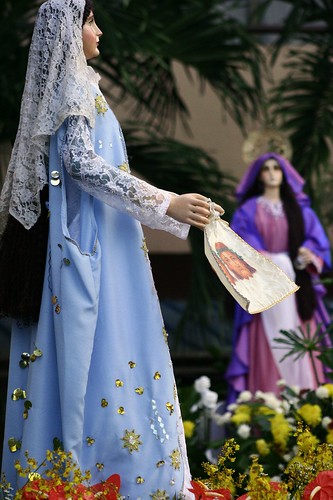
Canon EOS 350D Digital, 1/400, f/5.0, 120mm, ISO 800
the images of Veronica (Porcia family) and Maria Magdalena (Codoy family), Good Friday procession, Talamban, Cebu City
phototip: The assembly was in the local school so the background of buildings, electric wires could be distracting. Try to set an image against another, if possible.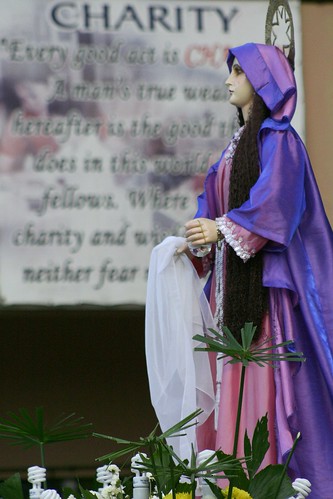
Canon EOS 350D Digital, 1/640s, f/5.0, 180mm, ISO 800
the image of Maria Magdalena of the Codoy family, Good Friday procession, Talamban, Cebu City. She holds the telltale white linen and bottle of perfume although these appear to be more appropriate for Easter Sunday’s Salubong/Sugat
phototip: Billboards could be offputting but I make it work by using a virtue signage as an allegory for the saint.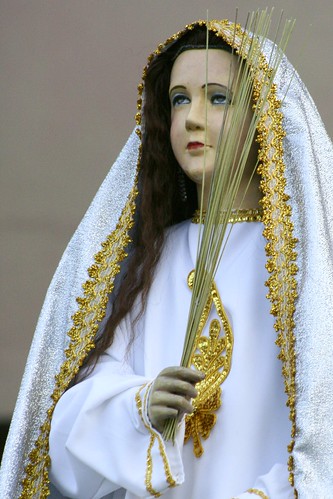
Canon EOS 350D Digital, 1/500s, f/5.0, 190mm, ISO 800, +2/3EV
the image of Martha, Good Friday procession, Talamban, Cebu City
phototip: For me, the simplicity of the icon’s garment and broom implement calls for a plain backdrop so I chose an angle and focal distance which set the image against the blank part of the wall.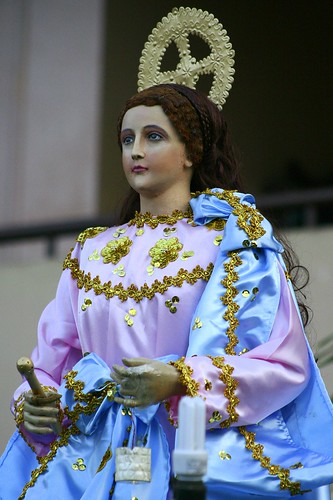
Canon EOS 350D Digital, 1/160s, f/5.0, 135mm, ISO 800, +2/3EV
the image of Maria Salome of the Entece family, Good Friday procession, Talamban, Cebu City
phototip: The carroza light bulbs can be unsightly. To make the lamp “disappear”, I chose an angle where the lamp aligns with the sleeve fold.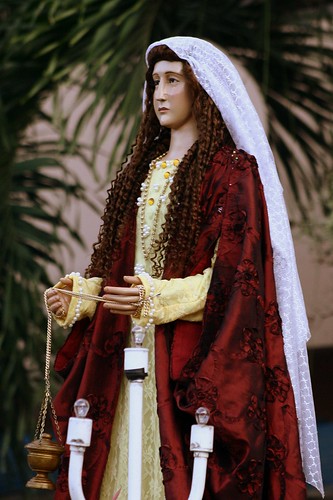
Canon EOS 350D Digital, 1/250s, f/5.0, 130mm, ISO 800
an image of Maria Cleofe, Good Friday procession, Talamban, Cebu City
phototip: In here, there is practically nothing I could do with the light fixtures anymore but the perspective was chosen to create the palm behind the cart as an attractive frame.
Prosesyon
I began taking pictures at 5PM just when the carrozas started to arrive and assemble in the parish school grounds adjacent to the church. Shortly thereafter, at 5:35PM, the procession began. The sky was getting dark. Processions, by tradition, are candlelit so they start before sundown in the Philippines.
All carrozas in Talamban are carts on wheels. They are hand-drawn. Yet there is no paucity of volunteers to help push the carts, which can be difficult considering the varying levels and conditions of the pavement.
Canon EOS 350D Digital, 1/100, f/5.0, 18mm, ISO 800, +1/3EV
pushing the carro of Salome (?) out of the San Isidro Parish School, Talamban, Cebu, the Philippines
phototip: To exaggerate the action, use a low and wide camera angle.
I am not one who can estimate crowd number but the procession was almost a kilometer long from end to end. People, from the religious to the curious, also lined up along streets so an attendance of four to five thousand was most likely.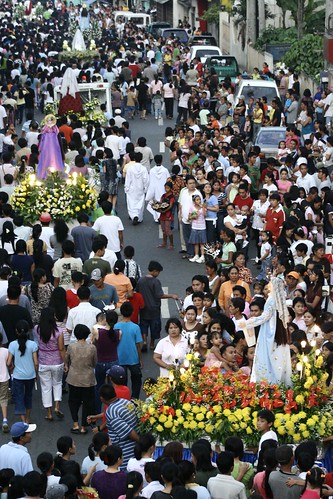
Canon EOS 350D Digital, 1/250s, f/5.6, 75mm, ISO 1600
the Good Friday procession just as it emerged into the streets, Talamban, Cebu, the Philippines
phototip: To capture a comprehensive view of the procession, find an elevated vantage point. I shot this from a skywalk (an elevated pedestrian cross “bridge”) so I can see at least 5 processional carts from end to end.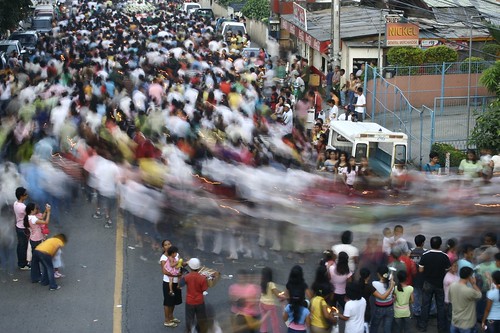
Canon EOS 350D Digital, 2.0s, f/29, 42mm, ISO 100
the Good Friday procession just as it emerged into the streets, Talamban, Cebu, the Philippines
phototip: Long exposure in daylight can be manipulated by chosing the narrowest aperture (f/29) at the lowest ISO. The relatively slow shutter speed of 2 seconds capture the fast-moving pace of the procession amidst the transfixed street audience.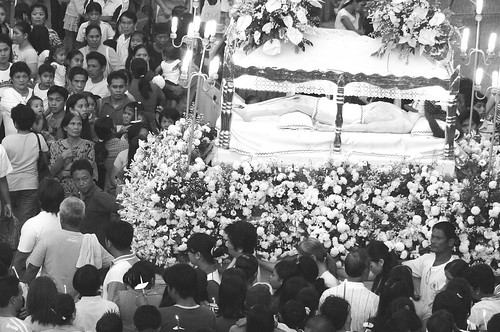
Canon EOS 350D Digital, 1/320s, f/5.6, 80mm, ISO 1600
Basco port, Batanes, the northernmost province of the Philippines
phototip: On the other hand, a fast exposure is necessary to freeze the various expressions of the crowd, especially upon passage of the centerpiece of the procession, the Santo Entierro. The ISO was pushed to its highest value at 1600 to prevent blur.
Processions are a community effort. No roads are sacred and for an hour and a half, traffic was brought to a standstill. The scene in Talamban is repeated in all parishes in the country and anyone who takes to the streets at sundown during Good Friday already knows what to expect. There would only be a few motorists anyway as after all, Viernes Santo is a sacred day when Christ has died. In the past, it is taboo to get out of the house, except of course, if you went to church.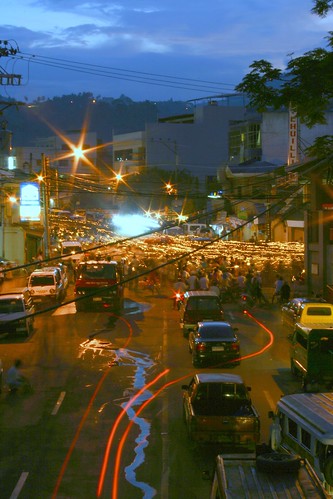
Canon EOS 350D Digital, 25.0s, f/36, 49mm, ISO 100, +1/3EV
the Good Friday procession literally stopped the traffic at Talamban, Cebu, the Philippines
phototip: The lines of traffic, the candlelight procession and even the power cables may be a mess but these can convey motion if taken in long exposures, especially during sunset.
to be concluded in part 2: tableaux, Santo Entierro and the Veneration






2 comments:
Hi. I've been an avid follower of your blog and have been grateful for your very precious phototips.
As for this set, I specially love your long exposures. :D
Fantastic photos Farl, a wonderful documentation and you are the best teacher ever with your phototips!
Thank you so much for sharing!
Post a Comment